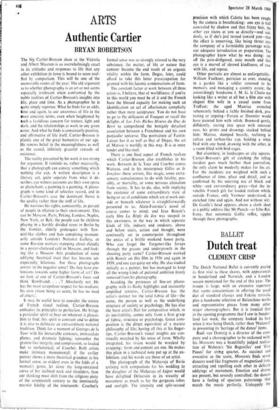Dutch treat
BALLET CLEMENT CRISP
The Dutch National Ballet is currently paying its first visit to these shores, with appearances in Sunderland and Norwich, and a London season mentioned for the end of this year. The troupe is large, with an extensive repertory that seems conscientious in offering the usual diet of standard classics and Fokine revivals, plus a handsome selection of Balanchine Works and representative pieces from many other major choreographers. But it is ironical that in the opening programme that I saw in Sunder- land last week, the company looked its best when it was being Dutch, rather than 'National' in presenting its 'heritage of the dance' items.
Rudi van Dantzig is a director of the com- pany and a choreographer to be reckoned with; his Moments was a beautifully judged realisa- tion of Webern's 'Six Bagatelles' and 'Five Pieces' for string quartet. As succinct and evocative as the score, Moments finds seven dancers used like fragments of magnetised iron, attracting and repelling each other in delicate eddyings of movement. Emotion and drama are present, but severely controlled; the dances have a feeling of spacious patternings that match the music perfectly. Unhappily the stagings of Petrushka and Les Sylphides hardly matched the music at all. Hindered by tape- recordings that offered minimal support to the choreography, both productions looked like blurred snapshots of masterpieces, with every point out of focus and every nuance lost. A national ballet of a very different kind is the Dagestan Dance Company at the Albert Hall. Folk dancing is my Dr Fell; the reason why I cannot tell—or not fully—but I certainly do not love it, try as I may. It is in part some- thing to do with unrelieved cheeriness, with booted feet that know only three steps, and with the appalling dullness of folk-music; partly be- cause of the sheer improbability of the view of life we are expected to accept. Just so with the ladies and gentlemen of Dagestan. The men spend much time on the knuckles of their black-booted feet, spinning like tops, wire- walking and crashing down on their knees with unabashed vigour. The women are very oriental in manner, gliding about like Victorian house- maids on castors, and registering the obligatory two emotions, languor and beady-eyed roguishness.
I find the whole thing as unreal as ballet's swans and fairy frolics, and infinitely less worth while to watch.



































 Previous page
Previous page